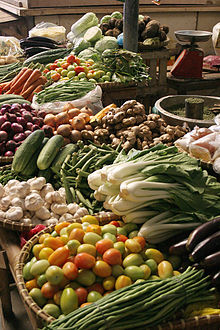**Vegetable Overview**:
– Etymology of the term ‘vegetable’ dating back to the 15th century.
– Evolution of the term from Old French to specifically mean plants cultivated for food.
– Historical context of vegetables in human diets and agriculture.
– Common vegetables like Brassica oleracea with details on parts used, origin, and production statistics.
– Production process of vegetables including cultivation, soil types, and climate considerations.
**Nutrition and Health Benefits**:
– Nutritional content of vegetables including fiber, vitamins, minerals, and antioxidants.
– Impact of vegetable consumption on reducing risks of cancer, stroke, and heart disease.
– Varied nutritional content of different vegetables and potential presence of toxins and antinutrients.
– Recommendations for daily vegetable intake by organizations like USDA and India.
**Production and Harvesting**:
– Global production of vegetables with China as the largest producer.
– Cultivation process involving soil preparation, planting, tending, and harvesting.
– Factors affecting vegetable production such as soil types, climate, and temperature.
– Harvesting techniques for different types of vegetables and the importance of proper post-harvest care.
**Preservation and Storage**:
– Techniques for preserving vegetables including canning, freezing, sun-drying, and fermentation.
– Importance of post-harvest care and storage to minimize losses.
– Technologies like cold storage and evaporative cooling for maintaining vegetable quality.
– Impact of preservation methods on the nutritional value of vegetables.
**Regulations and Research**:
– International standards set by ISO for vegetable products and services.
– Research on vegetable nutrition, cultivation practices, and therapeutic values.
– Dietary guidelines promoting vegetable intake by organizations like USDA and Harvard School of Public Health.
– Resources available for vegetable preservation, processing techniques, and botanical nomenclature.
Vegetables are parts of plants that are consumed by humans or other animals as food. The original meaning is still commonly used and is applied to plants collectively to refer to all edible plant matter, including the flowers, fruits, stems, leaves, roots, and seeds. An alternative definition of the term is applied somewhat arbitrarily, often by culinary and cultural tradition. It may exclude foods derived from some plants that are fruits, flowers, nuts, and cereal grains, but include savoury fruits such as tomatoes and courgettes, flowers such as broccoli, and seeds such as pulses.

Originally, vegetables were collected from the wild by hunter-gatherers and entered cultivation in several parts of the world, probably during the period 10,000 BC to 7,000 BC, when a new agricultural way of life developed. At first, plants that grew locally were cultivated, but as time went on, trade brought common and exotic crops from elsewhere to add to domestic types. Nowadays, most vegetables are grown all over the world as climate permits, and crops may be cultivated in protected environments in less suitable locations. China is the largest producer of vegetables, and global trade in agricultural products allows consumers to purchase vegetables grown in faraway countries. The scale of production varies from subsistence farmers supplying the needs of their family for food, to agribusinesses with vast acreages of single-product crops. Depending on the type of vegetable concerned, harvesting the crop is followed by grading, storing, processing, and marketing.
Vegetables can be eaten either raw or cooked and play an important role in human nutrition, being mostly low in fat and carbohydrates, but high in vitamins, minerals and dietary fiber. Many nutritionists encourage people to consume plenty of fruit and vegetables, five or more portions a day often being recommended.
